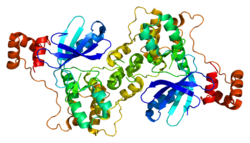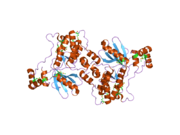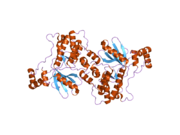MARK2
| MARK2 | |||||||||||||||||||||||||||||||||||||||||||||||||||
|---|---|---|---|---|---|---|---|---|---|---|---|---|---|---|---|---|---|---|---|---|---|---|---|---|---|---|---|---|---|---|---|---|---|---|---|---|---|---|---|---|---|---|---|---|---|---|---|---|---|---|---|
 | |||||||||||||||||||||||||||||||||||||||||||||||||||
| |||||||||||||||||||||||||||||||||||||||||||||||||||
| Identifiers | |||||||||||||||||||||||||||||||||||||||||||||||||||
| Aliases | MARK2, EMK-1, EMK1, PAR-1, Par-1b, Par1b, microtubule affinity regulating kinase 2 | ||||||||||||||||||||||||||||||||||||||||||||||||||
| External IDs | OMIM: 600526; MGI: 99638; HomoloGene: 69013; GeneCards: MARK2; OMA:MARK2 - orthologs | ||||||||||||||||||||||||||||||||||||||||||||||||||
| |||||||||||||||||||||||||||||||||||||||||||||||||||
| |||||||||||||||||||||||||||||||||||||||||||||||||||
| |||||||||||||||||||||||||||||||||||||||||||||||||||
| |||||||||||||||||||||||||||||||||||||||||||||||||||
| |||||||||||||||||||||||||||||||||||||||||||||||||||
| Wikidata | |||||||||||||||||||||||||||||||||||||||||||||||||||
| |||||||||||||||||||||||||||||||||||||||||||||||||||
Serine/threonine-protein kinase MARK2 is an enzyme that in humans is encoded by the MARK2 gene.[5][6][7]
Function
EMK (ELKL Motif Kinase) is a small family of ser/thr protein kinases involved in the control of cell polarity, microtubule stability and cancer. Several cDNA clones have been isolated that encoded two isoforms of the human ser/thr protein kinase EMK1. These isoforms were characterized by the presence of a 162-bp alternative exon that gave rise to two forms, one containing the exon and the other one lacking it. Both forms were found to be coexpressed in a number of selected cell lines and tissue samples. The human EMK1 was shown to be encoded by a single mRNA ubiquitously expressed.[7]
Interactions
MARK2 has been shown to interact with AKT1.[8]
References
- ^ a b c GRCh38: Ensembl release 89: ENSG00000072518 – Ensembl, May 2017
- ^ a b c GRCm38: Ensembl release 89: ENSMUSG00000024969 – Ensembl, May 2017
- ^ "Human PubMed Reference:". National Center for Biotechnology Information, U.S. National Library of Medicine.
- ^ "Mouse PubMed Reference:". National Center for Biotechnology Information, U.S. National Library of Medicine.
- ^ Espinosa L, Navarro E (Oct 1998). "Human serine/threonine protein kinase EMK1: genomic structure and cDNA cloning of isoforms produced by alternative splicing". Cytogenet Cell Genet. 81 (3–4): 278–82. doi:10.1159/000015046. PMID 9730619. S2CID 46869824.
- ^ Navarro E (Oct 1999). "Precise localization of D11S1226 to the human EMK1 gene at chromosome band 11q13 by sequence homology search". Cytogenet Cell Genet. 86 (1): 66–7. doi:10.1159/000015413. PMID 10516437. S2CID 26642331.
- ^ a b "Entrez Gene: MARK2 MAP/microtubule affinity-regulating kinase 2".
- ^ Dickey CA, Koren J, Zhang YJ, Xu YF, Jinwal UK, Birnbaum MJ, Monks B, Sun M, Cheng JQ, Patterson C, Bailey RM, Dunmore J, Soresh S, Leon C, Morgan D, Petrucelli L (Mar 2008). "Akt and CHIP coregulate tau degradation through coordinated interactions". Proc. Natl. Acad. Sci. U.S.A. 105 (9): 3622–7. Bibcode:2008PNAS..105.3622D. doi:10.1073/pnas.0709180105. PMC 2265134. PMID 18292230.
Further reading
- Courseaux A, Fernandes M, Grosgeorge J, Inglis J, Raynaud SD, Gaudray P (1995). "Human EMK1 is located on 11q12-q13, close to COX8 and FTH1". Mamm. Genome. 6 (4): 311–2. doi:10.1007/BF00352433. PMID 7613050. S2CID 37616665.
- Maruyama K, Sugano S (1994). "Oligo-capping: a simple method to replace the cap structure of eukaryotic mRNAs with oligoribonucleotides". Gene. 138 (1–2): 171–4. doi:10.1016/0378-1119(94)90802-8. PMID 8125298.
- Schultz SJ, Nigg EA (1994). "Identification of 21 novel human protein kinases, including 3 members of a family related to the cell cycle regulator nimA of Aspergillus nidulans". Cell Growth Differ. 4 (10): 821–30. PMID 8274451.
- Bonaldo MF, Lennon G, Soares MB (1997). "Normalization and subtraction: two approaches to facilitate gene discovery". Genome Res. 6 (9): 791–806. doi:10.1101/gr.6.9.791. PMID 8889548.
- Courseaux A, Grosgeorge J, Gaudray P, Pannett AA, Forbes SA, Williamson C, Bassett D, Thakker RV, Teh BT, Farnebo F, Shepherd J, Skogseid B, Larsson C, Giraud S, Zhang CX, Salandre J, Calender A (1997). "Definition of the minimal MEN1 candidate area based on a 5-Mb integrated map of proximal 11q13. The European Consortium on Men1, (GENEM 1; Groupe d'Etude des Néoplasies Endocriniennes Multiples de type 1)". Genomics. 37 (3): 354–65. doi:10.1006/geno.1996.0570. PMID 8938448.
- Drewes G, Ebneth A, Preuss U, Mandelkow EM, Mandelkow E (1997). "MARK, a novel family of protein kinases that phosphorylate microtubule-associated proteins and trigger microtubule disruption". Cell. 89 (2): 297–308. doi:10.1016/S0092-8674(00)80208-1. PMID 9108484. S2CID 15647848.
- Suzuki Y, Yoshitomo-Nakagawa K, Maruyama K, Suyama A, Sugano S (1997). "Construction and characterization of a full length-enriched and a 5'-end-enriched cDNA library". Gene. 200 (1–2): 149–56. doi:10.1016/S0378-1119(97)00411-3. PMID 9373149.
- Sun TQ, Lu B, Feng JJ, Reinhard C, Jan YN, Fantl WJ, Williams LT (2001). "PAR-1 is a Dishevelled-associated kinase and a positive regulator of Wnt signalling". Nat. Cell Biol. 3 (7): 628–36. doi:10.1038/35083016. PMID 11433294. S2CID 1128604.
- Brajenovic M, Joberty G, Küster B, Bouwmeester T, Drewes G (2004). "Comprehensive proteomic analysis of human Par protein complexes reveals an interconnected protein network". J. Biol. Chem. 279 (13): 12804–11. doi:10.1074/jbc.M312171200. PMID 14676191.
- Bouwmeester T, Bauch A, Ruffner H, Angrand PO, Bergamini G, Croughton K, Cruciat C, Eberhard D, Gagneur J, Ghidelli S, Hopf C, Huhse B, Mangano R, Michon AM, Schirle M, Schlegl J, Schwab M, Stein MA, Bauer A, Casari G, Drewes G, Gavin AC, Jackson DB, Joberty G, Neubauer G, Rick J, Kuster B, Superti-Furga G (2004). "A physical and functional map of the human TNF-alpha/NF-kappa B signal transduction pathway". Nat. Cell Biol. 6 (2): 97–105. doi:10.1038/ncb1086. PMID 14743216. S2CID 11683986.
- Lizcano JM, Göransson O, Toth R, Deak M, Morrice NA, Boudeau J, Hawley SA, Udd L, Mäkelä TP, Hardie DG, Alessi DR (2005). "LKB1 is a master kinase that activates 13 kinases of the AMPK subfamily, including MARK/PAR-1". EMBO J. 23 (4): 833–43. doi:10.1038/sj.emboj.7600110. PMC 381014. PMID 14976552.
- Hueso M, Beltran V, Moreso F, Ciriero E, Fulladosa X, Grinyó JM, Serón D, Navarro E (2004). "Splicing alterations in human renal allografts: detection of a new splice variant of protein kinase Par1/Emk1 whose expression is associated with an increase of inflammation in protocol biopsies of transplanted patients". Biochim. Biophys. Acta. 1689 (1): 58–65. doi:10.1016/j.bbadis.2004.01.008. PMID 15158914.
- Beausoleil SA, Jedrychowski M, Schwartz D, Elias JE, Villén J, Li J, Cohn MA, Cantley LC, Gygi SP (2004). "Large-scale characterization of HeLa cell nuclear phosphoproteins". Proc. Natl. Acad. Sci. U.S.A. 101 (33): 12130–5. Bibcode:2004PNAS..10112130B. doi:10.1073/pnas.0404720101. PMC 514446. PMID 15302935.
- Suzuki A, Hirata M, Kamimura K, Maniwa R, Yamanaka T, Mizuno K, Kishikawa M, Hirose H, Amano Y, Izumi N, Miwa Y, Ohno S (2004). "aPKC acts upstream of PAR-1b in both the establishment and maintenance of mammalian epithelial polarity". Curr. Biol. 14 (16): 1425–35. Bibcode:2004CBio...14.1425S. doi:10.1016/j.cub.2004.08.021. PMID 15324659. S2CID 293494.
- Cohen D, Rodriguez-Boulan E, Müsch A (2004). "Par-1 promotes a hepatic mode of apical protein trafficking in MDCK cells". Proc. Natl. Acad. Sci. U.S.A. 101 (38): 13792–7. Bibcode:2004PNAS..10113792C. doi:10.1073/pnas.0403684101. PMC 518835. PMID 15365179.
- Hazarika P, McCarty MF, Prieto VG, George S, Babu D, Koul D, Bar-Eli M, Duvic M (2004). "Up-regulation of Flotillin-2 is associated with melanoma progression and modulates expression of the thrombin receptor protease activated receptor 1". Cancer Res. 64 (20): 7361–9. doi:10.1158/0008-5472.CAN-04-0823. PMID 15492257.
- v
- t
- e
-
 1y8g: Catalytic and ubiqutin-associated domains of MARK2/PAR-1: Inactive double mutant with selenomethionine
1y8g: Catalytic and ubiqutin-associated domains of MARK2/PAR-1: Inactive double mutant with selenomethionine -
 1zmu: Catalytic and ubiqutin-associated domains of MARK2/PAR-1: Wild type
1zmu: Catalytic and ubiqutin-associated domains of MARK2/PAR-1: Wild type -
 1zmv: Catalytic and ubiqutin-associated domains of MARK2/PAR-1: K82R mutant
1zmv: Catalytic and ubiqutin-associated domains of MARK2/PAR-1: K82R mutant -
 1zmw: Catalytic and ubiqutin-associated domains of MARK2/PAR-1: T208A/S212A inactive double mutant
1zmw: Catalytic and ubiqutin-associated domains of MARK2/PAR-1: T208A/S212A inactive double mutant
 | This article on a gene on human chromosome 11 is a stub. You can help Wikipedia by expanding it. |
- v
- t
- e




















